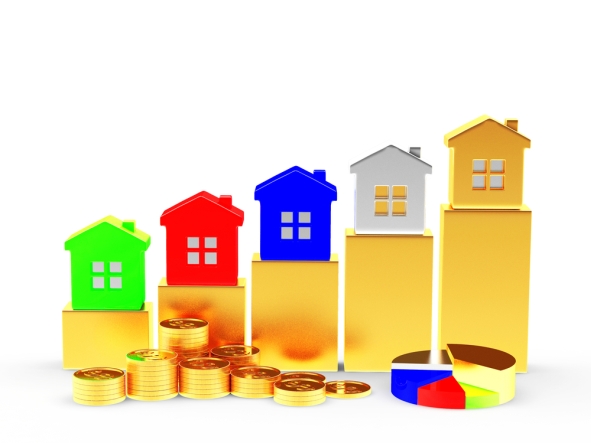 Since the Bank of England dropped interest rates to 0.5% in March 2009 house prices have risen by almost £60,000, new research shows.
Since the Bank of England dropped interest rates to 0.5% in March 2009 house prices have risen by almost £60,000, new research shows.
According to online estate agents HouseSimple.com, average UK property prices have risen 41.2% over the past eight years since interest rates came crashing down.
Average prices in Cambridge have almost doubled since March 2009, while average London prices have broken through the £500,000 ceiling.
However this golden period could be about to come to an end due to rising inflation. Last week, three members of the Bank’s Monetary Policy Committee voted to hike rates by 0.25 basis points to 0.50% – the closest it has come to raising rates since 2007.
The decision comes after inflation hit a four-year-high of 2.9% in May – well above the Bank’s target of 2%.
The South East has fared particularly well, with seven of the 10 biggest property price rises since March 2009.
Cambridge, London and Slough have all seen average house price growth in excess of 90%.
However, at the other end of the performance chart, Hartlepool (9% drop), Durham (6.2% drop), Middlesbrough (4.5% drop) – all in the North East – have seen prices fall.
Across London, average house price growth has been particularly strong during this unprecedented time of record low interest rates, with prices rising on average 90.8%.
The borough of Kensington and Chelsea tops the chart, with average prices increasing by 128.9%, while the less glamorous boroughs of Haringey and Waltham Forest have witnessed impressive price growth since March 2009, with price growth of 111.7% and 106.4% respectively.
Surprisingly, the trendy borough of Camden (74.9%) was one of the worst performing boroughs, although average prices have still grown over 30% more than the UK as a whole.
Alex Gosling, CEO of online estate agents HouseSimple.com, said: “While UK savers have suffered over the past eight years, millions of homeowners have increased their equity in their homes substantially in this once-in-a-generation low interest rate environment. It’s been a golden period for UK homeowners, but there are signs that it could be coming to an end as the MPC narrowly voted to hold interest rates at 0.25%.
“House prices are also under pressure from the political and economic uncertainty of Brexit and the fallout from the disastrous General Election result for the Conservative Party. There is no evidence to suggest that property prices are about to plummet, but homeowners and home buyers do need to plan ahead, and make sure they can cover the impact of interest rate rises on their monthly mortgage payments.
“Many homeowners will have never seen an interest rate rise, and may believe rates will never rise. But they will eventually, and when they do, we could see rates rise by 1%-2% quite quickly. With many households already feeling the strain of higher day-to-day costs, monthly mortgage payments going up by several hundred pounds a month could tip them over the edge.”
UK towns and cities that have seen the biggest rises in average property prices since interest rates fell to 0.5% in March 2009
| Town/City | Region | Average Property Price – March 2009 (£) | Average Property Price – April 2017 (£) | % Increase in property price |
| Cambridge | East | 224,469 | 441,527 | 96.7 |
| London | South East | 278,186 | 530,751 | 90.8 |
| Slough | South East | 160,774 | 305,649 | 90.1 |
| Oxford | South East | 228,586 | 415,843 | 81.9 |
| Watford | East | 200,219 | 360,396 | 80.0 |
| Milton Keynes | South East | 147,903 | 262,241 | 77.3 |
| Hemel Hempstead | East | 230,686 | 406,312 | 76.1 |
| Luton | South East | 132,001 | 231,315 | 75.2 |
| Brighton | South East | 202,564 | 353,195 | 74.4 |
| Crawley | South East | 158,285 | 273,517 | 72.8 |
| Stevenage | South East | 160,350 | 276,201 | 72.2 |
| Guildford | South East | 261,614 | 444,232 | 69.8 |
| Reading | South East | 177,688 | 301,443 | 69.6 |
| Colchester | East | 149,654 | 253,618 | 69.5 |
| Woking | South East | 244,218 | 411,303 | 68.4 |
UK towns and cities that have seen the worst property price growth since interest rates fell to 0.5% in March 2009
| Town/City | Region | Average Property Price – March 2009 (£) | Average Property Price – April 2017 (£) | % Increase/ (decrease) in property price |
| Hartlepool | North East | 110,231 | 100,291 | -9.0 |
| Durham | North East | 102,003 | 95,638 | -6.2 |
| Middlesbrough | North East | 118,605 | 113,285 | -4.5 |
| Blackburn | North West | 104,105 | 103,075 | -1.0 |
| Preston | North East | 111,264 | 111,414 | 0.1 |
| Swansea | North West | 100,676 | 102,243 | 1.6 |
| Rochdale | North West | 120,616 | 124,191 | 3.0 |
| St Helens | Wales | 129,556 | 137,840 | 6.4 |
| Southport | North West | 110,562 | 118,552 | 7.2 |
| Wakefield | North West | 110,687 | 118,904 | 7.4 |
| Carlisle | North West | 142,122 | 152,719 | 7.5 |
| Gateshead | West Yorkshire | 126,419 | 135,998 | 7.6 |
| Barnsley | South Yorkshire | 104,029 | 113,419 | 9.0 |
| Doncaster | South Yorkshire | 109,427 | 120,098 | 9.8 |
| Glasgow | Scotland | 104,902 | 115,180 | 9.8 |




